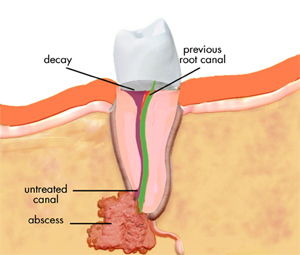Root Canal
Stoma Advanced Dental Care is equipped with a good team of experienced Endodontists who will study your
condition before administering any treatment. We provide you the best in endodontic
care with technologically advanced facilities and modern dental practices.
A root canal can save a tooth that would otherwise not survive due to severe damage,
infection or decay. Although there is a popular misconception that root canals are
painful, they are in fact a comfortable general dental procedure that is designed
to bring patients out of pain. If you are experiencing discomfort from an infected
tooth, trust Stoma Advanced Dental Care for top quality root canal therapy.
We maintain a warm, comfortable environment and are proud of the individual attention
we offer to each patient. State-of-the-art techniques, such as the surgical operating
microscope to enhance efficiency and treatment results, are used.
We hope that the information provided here answer many of your questions about endodontic
treatment. If you would like additional information, please don't hesitate to contact
us at Stoma Advanced Dental Care.
Stoma’s Edge
Root Canal Treatment is needed when the blood or nerve supply of the tooth (known
as the pulp) is infected through tooth decay or injury. You may not feel any pain
in the early stages of the infection. In some cases your tooth could darken in color
which may mean that the nerve of the tooth has died (or is dying).
At your initial appointment dentists will conduct a comprehensive examination to
diagnose orofacial pain and pulpal injury and determine if the tooth needs endodontic
therapy (root canal treatment). Most endodontic treatment can be done the same day
as the consultation.
However, a complex treatment plan or medical history may require an evaluation and
a second appointment to provide treatment on another day. Please assist us by providing
the following information at the time of your consultation.
Your endodontic referral slip and any x-rays, if applicable. Please note that we
may take our own x-rays to provide you with a comprehensive diagnosis.
A list of medications you are presently taking.
Important: All patients under the age of 18 years of age must be accompanied by
a parent or guardian at the consultation visit.
Please alert the clinic if you have a medical condition that may be of concern prior
to treatment (i.e. diabetes, high blood pressure, artificial heart valves and joints,
rheumatic fever, etc.) or if you are on any medication (i.e. heart medications,
aspirin, anticoagulant therapy, etc.)
Treatment procedure
Preliminary treatment removes the decay and the source of infection of the pulp,
and also determines whether the lost tooth structure can be restored. If a fracture
of the tooth has reached the pulp, or infection is associated with gum disease,
it could be more difficult, if not impossible, to save the tooth.
The general sequence of a root canal procedure is as follows:
Step 1
Local anaesthesia is administered via injections to numb the tooth to be treated
and the surrounding tissues. If the pulp in a tooth is acutely inflamed, and therefore
very painful, it may take a while to get it numb, but your dentist will not start
the treatment until it is.
Step 2
A dental dam — a thin sheet of rubber or vinyl — will be placed over the affected
and adjacent teeth to isolate infected tooth from the rest of the mouth. The tooth
undergoing treatment protrudes through a hole punched in the dam. This allows the
root canal treatment to be carried out in a sterile environment free from contamination
by bacteria found in saliva or the rest of the mouth
Step 3
A small access hole is drilled through the biting surface of an affected back tooth
or from behind a front tooth, allowing access to the pulp chamber and root canals
for treatment.
Step 4
The diseased and dead pulp tissue is removed from the tooth with specially designed
instruments used to clean out the root canals and pulp chamber. This is not painful;
the area is numb and the tissue being removed is either dead or dying. Once the
pulp, along with the nerves contained in it, is removed, the tooth itself can no
longer feel pain.
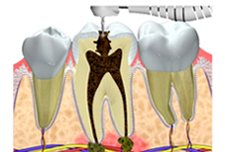
An opening is made in the crown to reach the pulp.
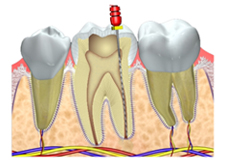
Removal of infected pulp and toxins from canal
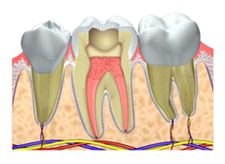
Filling rubber cones and paste in to canal is carried out
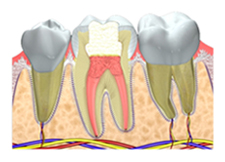
A permanent filling is done
Step 5
The canals are disinfected with antiseptic and antibacterial solutions.
Step 6
The canals are then shaped with tiny flexible instruments to allow them to receive
root canal fillings and sealers. The canals are washed and cleaned again to remove
root canal debris prior to sealing them.
Step 7
Root canal fillings are selected that will exactly fit into the freshly prepared
canals. Usually a rubber-like material called gutta-percha is used to fill the canal
space. It is a thermoplastic material (“thermo” – heat; “plastic” – to shape), which
literally is heated and then compressed into and against the walls of the root canals
to seal them. Together with adhesive cement called a sealer, the gutta-percha fills
the prepared canal space. Sealing the canals is critically important to prevent
them from becoming reinfected with bacteria.
Step 8
A temporary or permanent filling material will then be placed to seal the access
hole that was made to treat the canals, and the dental dam is removed. If the tooth
lacks sufficient structure to hold a restoration (filling) in place, the dentist
or endodontist may place a post (either metal or a very strong plastic) in one of
the canals inside the tooth to help retain it.
Step 9
Root canal filling material (gutta percha) is placed in the canals and the tooth
is sealed with a temporary filling to protect it from contamination. Then a crown
is usually placed over the tooth to seal and protect it from recontamination and
future damage. After the procedure, an antibiotic may be prescribed to treat or
prevent infection. Be sure to follow the instructions of your dentist or endodontist
carefully. After- effects of treatment are minimal, generally lasting from a couple
of days to about a week. It is normal to have some minor discomfort after treatment
including slight soreness that can usually be managed with over-the-counter (aspirin,
ibuprofen) medications or prescription (codeine-type) drugs, or a combination of
the two.
Step 10
Your tooth will need a permanent restoration — a filling or a crown — to replace
lost tooth structure, and provide a complete seal to the top of the tooth. Your
endodontist will send you back to your general dentist to determine which type of
restoration is best for you. This step is of particular importance since many studies
show that if the filled root canals are recontaminated with bacteria from the mouth,
there could be a recurrence of infection around the tooth
Root Canal Treatment
With the appropriate care, your teeth that have had endodontic treatment will last
as long as other natural teeth. Yet, a tooth that has received treatment may fail
to heal or pain may continue to exist. Sometimes, the pain may occur months or years
after treatment. If so, Endodontic Retreatment may be needed.
Improper Healing May be Caused by:
-
Curved or narrow canals were not treated during the initial treatment.
-
Complicated canals went undetected during the initial treatment.
-
The crown or restoration was not placed within the appropriate amount of time following
the procedure.
-
The crown or restoration did not prevent saliva from contaminating the inside of
the tooth.
-
In some cases, new problems can influence a tooth that was successfully treated.
-
New decay can expose a root canal filling material, causing infection.
-
A cracked or loose filling or crown can expose the tooth to new infection.
-
Once retreatment has been prescribed.
At this point, you will need to return to your dentist as soon as possible in order
to have a new crown or restoration placed on the tooth to restore full functionality.
Treatment procedures for children
An injured immature tooth may need one of the following procedures: -
Apexogenesis
This procedure encourages the root to continue development as the pulp is healed.
The injured pulp is covered with medication to encourage growth. The tip of the
root (apex) will continue to close as the child gets older. In turn, the walls of
the root canal will thicken. If the pulp heals, no additional treatment will be
necessary. The more mature the root becomes, the better the chances saving the tooth.
Apexification
In this case, the unhealthy pulp is removed. The endodontist places medication into
the root to help a hard tissue form near the root tip. This hardened tissue provides
a barrier for the root canal filling. At this point, the root canal walls will not
continue to develop, making the tooth susceptible to fractures. So it is important
to have the tooth properly restored by your dentist.
Opt for Endodontic (Root Canal)
The dentist at Stoma Advanced Dental Care will recommend Endontic treatment or root canal if you suffer
from the following ailment: -
Cracked Teeth
Cracked teeth demonstrate many types of symptoms, including pain when chewing, temperature
sensitivities, or even the release of biting pressure. It is also common for pain
to come and go, making it difficult to diagnose the cause of discomfort.
This type of crack extends from the chewing surface of the tooth and vertically
migrates towards the root. In some cases, the crack may extend below the gum line.
It is possible for the crack to extend further into the root. Damage to the pulp
is common place. In this case, root canal treatment is usually necessary. A cracked
tooth that is not treated will worsen, resulting in the loss of the tooth. Therefore,
early detection is essential.
Chewing can cause movement of the cracked pieces of your tooth, and the pulp within
the tooth becomes irritated. At the same time, when biting pressure is released,
the crack can close quickly, resulting in sharp pain. Eventually, the pulp will
become damaged and tooth will consistently hurt, even when you are not chewing.
It is possible that cracks can lead to infection of the pulp tissue, which can spread
to the bone and gum surrounding the problematic tooth.
Types of Cracks
Craze Lines : These are tiny cracks that only affect the outer
enamel of the tooth. These cracks are more common in adults. These types of cracks
are superficial and are usually of no concern.
Fractured Cusp: When a cusp becomes weakened, a fracture may result.
The cusp may break off or be removed by a dentist. A fractured cusp rarely damages
the pulp, so root canal is not necessary. Your dentist will usually restore the
tooth with a full crown.
Split Tooth: A split tooth is usually the result of an untreated
cracked tooth. It can be identified by a crack with distinct segments. This type
of tooth can never be saved intact. Yet, the position and extent of the problem
will dictate whether any portion of the tooth can be saved. Sometimes, endodontic
retreatment by dentist and restoration by your dentist can be used to save a portion
of the tooth.
Vertical Root Fracture : A vertical root fracture begins at the
root and extends towards the chewing surface of the tooth. Unfortunately, they show
minimal symptoms and may go unnoticed. Treatment involves endodontic surgery if
a portion of the tooth can be saved by removal of the fractured root. Otherwise
the tooth will have to be extracted.
Traumatic Injuries
There are traumas which can be cured by root canal treatment: -
Dislodged Teeth: Injuries to the mouth can cause teeth to be pushed
back into their sockets. Your Endodontist or general dentist may reposition and
stabilize your tooth. Root canal treatment is usually started within a few weeks
of the injury and a medication, such as calcium hydroxide, will be placed inside
the tooth. Eventually, a permanent root canal filling will be implanted.Sometimes
a tooth may be pushed partially out of the socket. Again, If the pulp remains healthy,
then no other treatment is necessary. However, if the pulp becomes damaged or infected,
root canal treatment will be required
Avulsed Teeth: If an injury causes a tooth to be completely knocked
out of your mouth, it is important that you are treated immediately! If this happens
to you, keep the tooth moist. If possible, put it back into the socket. A tooth
can be saved if it remains moist. You can even put the tooth in milk or a glass
of water (add a pinch of salt.) Your Endodontist may start root canal treatment
based upon the stage of root development. The length of time the tooth was out of
your mouth and the way the tooth was stored, may influence the type of treatment
you receive. Stoma Advanced Dental Care offers a good team of experienced Endodontists who will study
your condition before administering any treatment. We provide you the best in endodontic
care with technologically advanced facilities and modern dental practices. If you
seek additional information, please don’t hesitate to contact us.
